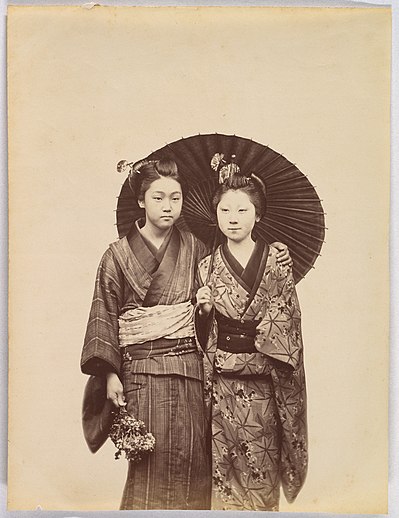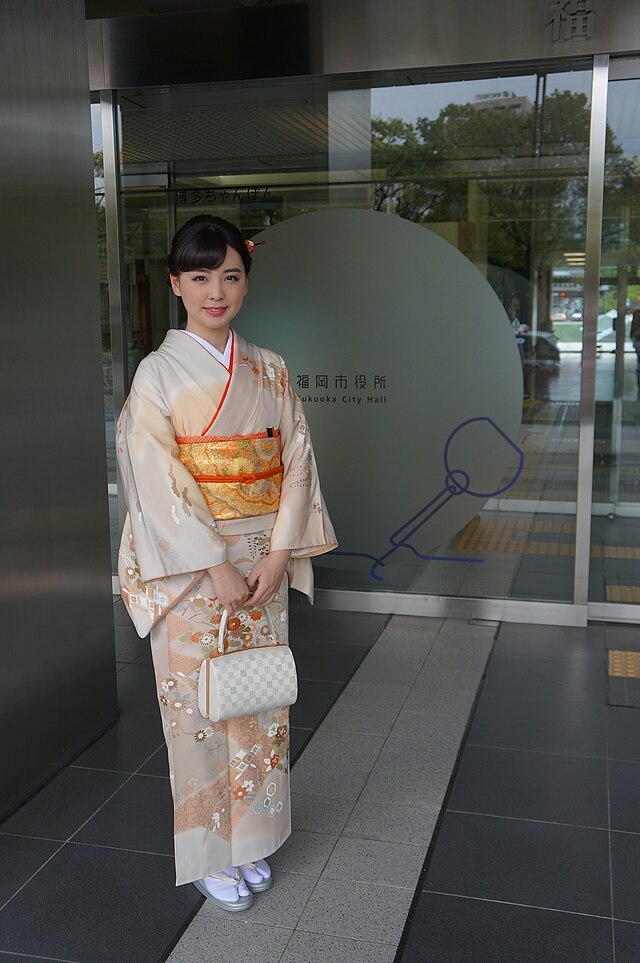Kimono History Definition
From the Nara period 710-794 until then Japanese people typically wore either. But in more recent years the word has been used to refer specifically to traditional Japanese clothing.

The Kimono Is A Simple Garment With A Complex History That Has Been Shaped By The Evolution Of Weaving Dyeing Japanese Outfits Japanese Fashion Japan Fashion
That is to say what we including modern Japanese now term kimono was in fact a full spectrum of attire in the pre-globalized period2 One remaining clue to the kimonos long and storied path through.

Kimono history definition. The Kimono is the traditional dress of Japan. The Japanese word kimono 着物 translates to thing to wear 着 ki wear and 物 mono thing but this simple definition is eclipsed by the many different variations and styles that the kimono encompasses. Kimono definition is - a long robe with wide sleeves traditionally worn with a broad sash as an outer garment by the Japanese.
In modern day the kimono is worn in special occasions such as the Shichi-Go-San. Kimono went through various transformations in terms of style fabric and design. But in reality kimonos are one of the most fashionable attires from Eastern CultureSet back in the Heian period kimono was born.
In this article I use the kimono as a jumping-off point to think through some issues of contemporary cross-cultural performance trying to articulate the current stakes of cultural appropriation in part through a brief history of kimono and its international transcultural influences over time and to think. What is the Kimono. Kimonos come in a range of styles and patterns.
The kimono is a traditional garment that captures the exquisite elegance of Japanese culture and design. Let us have a look at their history first. In Japan a Kimono is worn by both men and women.
Japan has a very rich textile history with the kimono being a major focus of interest and artistic expression. As if there were only two mutually exclusive sides to this kimono. Japanese Kimono emphasizes the wearers taste for class and modesty due to its breath-taking colors as well as its design.
The origin of kimono goes back to 1000 years ago and has long history. Literally meaning thing to wear 着物 its roots can be traced back to the Nara Period 710-794 when aristocratic women of the imperial court wore clothes with. People started to recognize that Komon means printing patterns as a generic name.
Originally worn by commoners or as an undergarment by the aristocracy from the 16th century kimono became the principal item of dress for all classes and both sexes. It has long sleeves and reaches from the shoulders all the way down to ones heels. The status of Kimono is under Tsukesage and upon Tsumugi plus Omeshi.
Kimono was considered as the traditional Japanese clothing. Its long history is one of the best examples of how clothing confers a sense of identity. Kimonos as we know them today came into being during the Heian period 794-1192.
Meaning the thing to wear the term kimono was first adopted in the mid-19th century. Komon is named for the little pattern but from the late of Meiji Era definition has changed. Kimono garment worn by Japanese men and women from the Hakuhō Early Nara period 645710 to the present.
It has neither buttons nor ties being lapped left over right. What is kimono There is Kimono as one of the traditional culture in Japan. They are typically hand-sewn into a T shape from 4 single pieces of fabric called tans and tied with an obi or belt.
The color and pattern would also change by the season and many iterations existed for all manner of occasion from ones emergence from a bath to working in a field to advertising oneself as a prostitute. It is very attractive wear. Straight cuts from a fabric which is then sewn together to create a garment to fit every body type.
Length of the Kimono cloth is generally 12 meters and the same patterns are printed repeatedly. As a UK-based lecturer and consultant on Japanese culture Akemi Tanaka has helped to promote the traditions of. It became the traditional clothing around late 700s and everyone in Japan used to wear their Kimonos all the time men women and.
The kimono used to be decorated with the wearers family crest. Kimono has many kinds and different among seasons and scenes. Kimono in English means wearing thing But the garment everyone associates with Japan was not always called by that name.
The kimono occupies inexplicable spaces in the notion of Western clothes and in the age in which fashion was shifting to a freer definition of shape and form this different sense of space gave. The kimonos form was first introduced from China as an undergarment. Derived from the Chinese pao-style robe the essential kimono is an ankle-length gown with long expansive sleeves and a V-neck.
Different types of Kimono are worn depending on the occasion. The kimono is perhaps the most iconic item of traditional Japanese clothing. Originally kimono was the Japanese word for clothing.
Kimonos for everyday wear are a lot simpler than those for formal occasions. Kimonos definition in the English dictionary is a wearing thing. Its use as a normal form of dress for men and women da.
The kimono is a simple garment with a complex history that has been shaped by the evolution of weaving dyeing and embroidery techniques as well as cultural changes in Japan. About 400 years ago it has been familiar with Japan. Exploring the history and tradition of Japanese clothing.
In general the term kimono originally meant something to wear. The first ancestor of the kimono was born in the Heian period 794-1192. Derived from the words ki wear and mono thing the kimono is a traditional Japanese garment.

Sashiko Stitching Wikipedia The Free Encyclopedia Japanese Embroidery Sashiko Japanese Textiles

Jinseinohana Angel Heart Thistle Kimono Japanese Traditional Dress Pretty Kimonos Beautiful Kimonos

The Surprising History And Fascinating Evolution Of The Japanese Kimono Japan History Japanese Kimono Japanese Art

Pin On Nacionalnyj Kostyum Odezhda
30 Things You Need To Know About Japanese Kimono Japan Objects Store

Hanami About Kimono Wedding Kimono Cherry Blossom Wedding Inspiration Hanami

Kimono In 2021 Traditional Outfits Japanese Outfits Kimono

What Is A Kimono Some Interesting Facts About This Traditional Japanese Clothing Sew Guide Ropa Japonesa Kimono Tradicional Japon Cultura






Posting Komentar untuk "Kimono History Definition"